9.2 Language and Thought
Imagine an alien species that could pass thoughts from one head to another merely by pulsating air molecules in the space between them. Perhaps these weird creatures could inhabit a future science fiction movie?
Actually, we are those creatures. When we speak, our brain and voice apparatus conjure up air-
language our spoken, written, or signed words and the ways we combine them to communicate meaning.
But language is more than vibrating air. As I [DM] create this paragraph, my fingers on a keyboard generate electronic binary numbers that are translated into the squiggles in front of you. When transmitted by reflected light rays into your retina, those squiggles trigger formless nerve impulses that project to several areas of your brain, which integrate the information, compare it to stored information, and decode meaning. Thanks to language, information is moving from my mind to yours. Monkeys mostly know what they see. Thanks to language (spoken, written, or signed), we comprehend much that we’ve never seen and that our distant ancestors never knew.
If you were able to retain only one cognitive ability, make it language, suggests researcher Lera Boroditsky (2009). Without sight or hearing, you could still have friends, family, and a job. But without language, could you have these things? “Language is so fundamental to our experience, so deeply a part of being human, that it’s hard to imagine life without it.”
Language Structure
9-
Consider how we might go about inventing a language. For a spoken language, we would need three building blocks:
phoneme in a language, the smallest distinctive sound unit.
morpheme in a language, the smallest unit that carries meaning; may be a word or a part of a word (such as a prefix).
grammar in a language, a system of rules that enables us to communicate with and understand others. In a given language, semantics is the set of rules for deriving meaning from sounds, and syntax is the set of rules for combining words into grammatically sensible sentences.
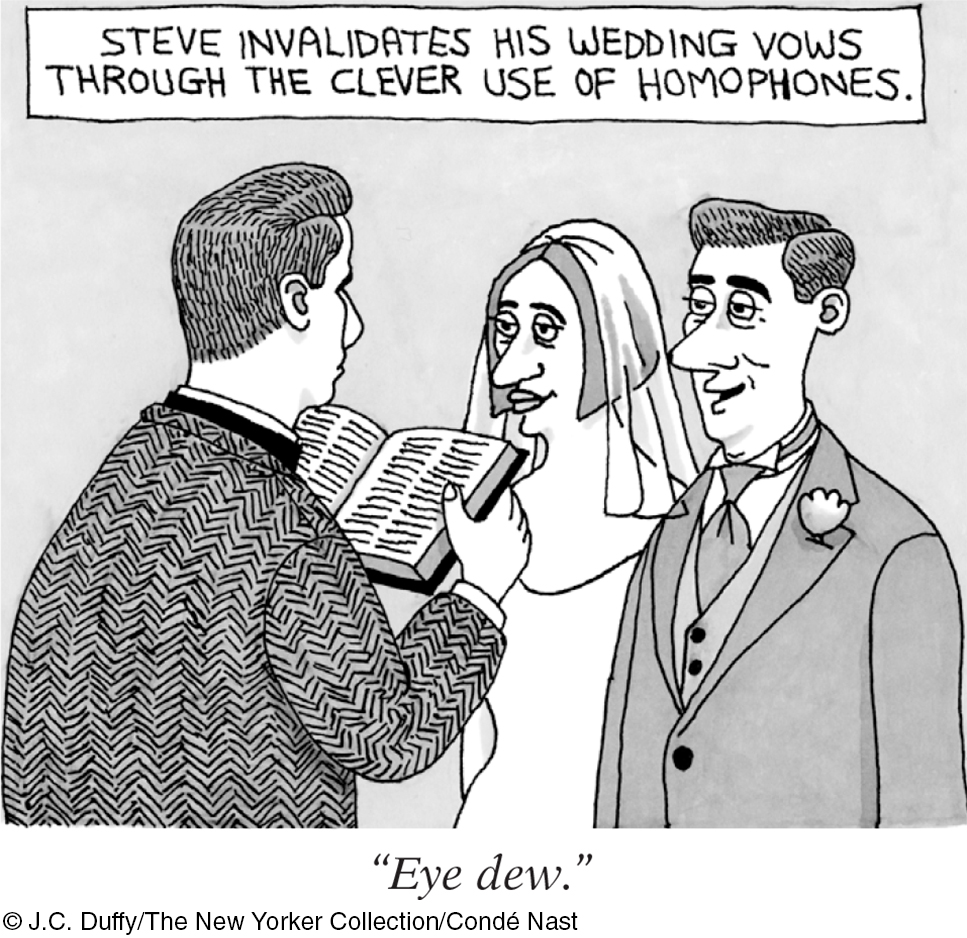
Phonemes are the smallest distinctive sound units in a language. To say bat, English speakers utter the phonemes b, a, and t. (Phonemes aren’t the same as letters. That also has three phonemes—
th, a, and t.) English uses about 40; other languages use anywhere from half to more than twice that many. As a general rule, consonant phonemes carry more information than do vowel phonemes. The treth ef thes stetement shed be evedent frem thes bref demenstretien. Morphemes are the smallest language units that carry meaning. Most morphemes combine two or more phonemes. Some are words, while others are parts of words. The word “readers,” for example, contains three morphemes: “read,” “er” (signaling that we mean “one who reads”), and “s” (signaling that we mean not one, but multiple readers). Every word in a language contains one or more morphemes.
Grammar is the system of rules that enables us to communicate—
by deriving meaning from sounds (semantics) and ordering words into sentences (syntax).
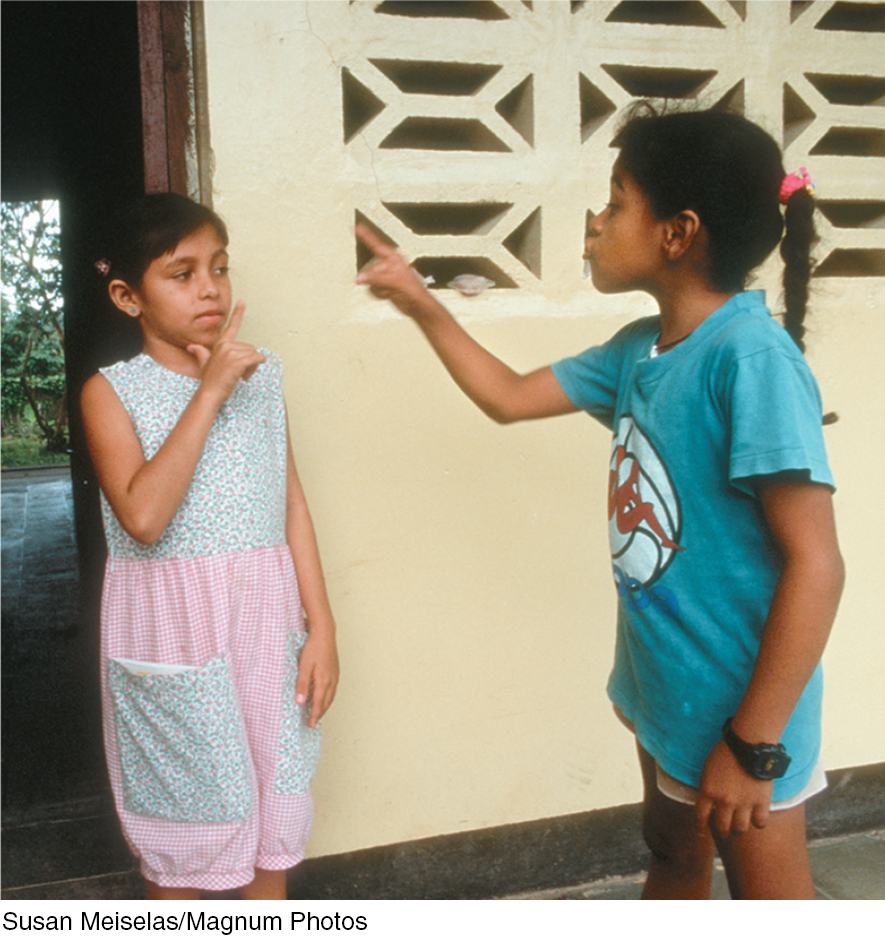
Like life constructed from the genetic code’s simple alphabet, language is complexity built of simplicity. In English, for example, 40 or so phonemes can be combined to form more than 100,000 morphemes, which alone or in combination produce the 616,500 word forms in the Oxford English Dictionary. Using those words, we can then create an infinite number of sentences, most of which (like this one) are original.
Linguist Noam Chomsky has argued that all languages share some basic elements, which he calls universal grammar. All human languages, for example, have nouns, verbs, and adjectives as grammatical building blocks. From infancy onward, humans, no matter their language, prefer some syllables, such as blif, over others, such as lbif (Gómez et al., 2014). Nevertheless, the world’s 6000+ languages are structurally very diverse (Evans & Levinson, 2009)—much more diverse than the universal grammar idea implies (Bergen, 2014; Ibbotson, 2012). Behaviorist B. F. Skinner (1957) believed we can explain this diversity with familiar learning principles, such as association (of the sights of things with the sounds of words); imitation (of the words and syntax modeled by others); and reinforcement (with smiles and hugs when the child says something right).
Chomsky also argued that humans are born with a built-
RETRIEVE IT
Question
How many morphemes are in the word cats? How many phonemes?
Language Development
9-
Make a quick guess: How many words of your native language(s) did you learn between your first birthday and your high school graduation? Although you use only 150 words for about half of what you say, you probably learned about 60,000 words (Bloom, 2000; McMurray, 2007). That averages (after age 2) to nearly 3500 words each year, or nearly 10 each day! How you did it—
Could you even state the rules of syntax (the correct way to string words together to form sentences) in the language(s) you speak fluently? Most of us cannot. Yet before you were able to add 2 + 2, you were creating your own original and grammatically appropriate sentences. As a preschooler, you comprehended and spoke with a facility that puts to shame college students struggling to learn a new language.
We humans have an astonishing facility for language. With remarkable efficiency, we sample tens of thousands of words in our memory, effortlessly assemble them with near-
When and How Do We Learn Language?
RECEPTIVE LANGUAGE Children’s language development moves from simplicity to complexity. Infants start without language (in fantis means “not speaking”). Yet by 4 months of age, babies can recognize differences in speech sounds (Stager & Werker, 1997). They can also read lips: They prefer to look at a face that matches a sound, so we know they can recognize that ah comes from wide open lips and ee from a mouth with corners pulled back (Kuhl & Meltzoff, 1982). This marks the beginning of the development of babies’ receptive language, their ability to understand what is said to and about them. Infants’ language comprehension greatly outpaces their language production. Even at six months, long before speaking, many infants recognize object names (Bergelson & Swingley, 2012, 2013). At 7 months and beyond, babies grow in their power to do what adults find difficult when listening to an unfamiliar language: to segment spoken sounds into individual words.
babbling stage beginning at about 4 months, the stage of speech development in which the infant spontaneously utters various sounds at first unrelated to the household language.
PRODUCTIVE LANGUAGE Long after the beginnings of receptive language, babies’ productive language, their ability to produce words, matures. Before nurture molds their speech, nature enables a wide range of possible sounds in the babbling stage, beginning around 4 months. Many of these spontaneously uttered sounds are consonant-

By about 10 months old, infants’ babbling has changed so that a trained ear can identify the household language (de Boysson-
one-word stage the stage in speech development, from about age 1 to 2, during which a child speaks mostly in single words.
Around their first birthday, most children enter the one-word stage. They have already learned that sounds carry meanings, and if repeatedly trained to associate, say, fish with a picture of a fish, 1-
two-word stage beginning about age 2, the stage in speech development during which a child speaks mostly in two-
telegraphic speech early speech stage in which a child speaks like a telegram—
At about 18 months, children’s word learning explodes from about a word per week to a word per day. By their second birthday, most have entered the two-word stage (TABLE 9.1). They start uttering two-
Summary of Language Development
| Month (approximate) | Stage |
| 4 | Babbles many speech sounds (“ah- |
| 10 | Babbling resembles household language (“ma- |
| 12 | One- |
| 24 | Two- |
| 24+ | Rapid development into complete sentences. |
Moving out of the two-

RETRIEVE IT
Question
What is the difference between receptive and productive language, and when do children normally hit these milestones in language development?
CRITICAL PERIODS Childhood seems to represent a critical (or “sensitive”) period for mastering certain aspects of language before the language-

The window on language learning closes gradually in early childhood. Later-
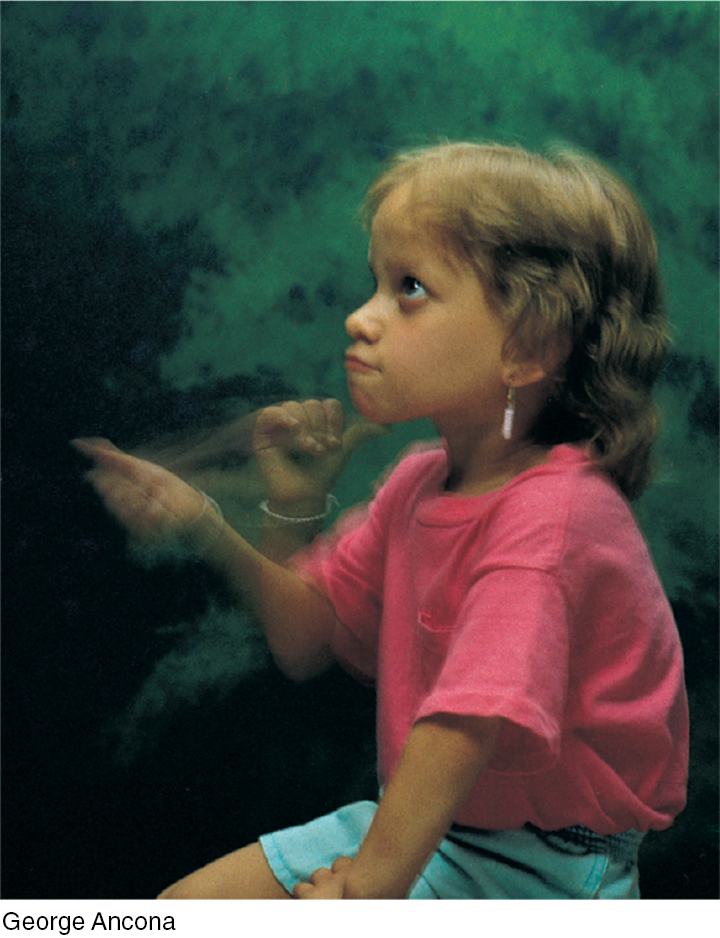
“Children can learn multiple languages without an accent and with good grammar, if they are exposed to the language before puberty. But after puberty, it’s very difficult to learn a second language so well. Similarly, when I first went to Japan, I was told not even to bother trying to bow, that there were something like a dozen different bows and I was always going to ‘bow with an accent.’”
Psychologist Stephen M. Kosslyn, “The World in the Brain,” 2008
Deafness and Language Development
The impact of early experiences is evident in language learning in prelingually (before learning language) deaf children born to hearing-
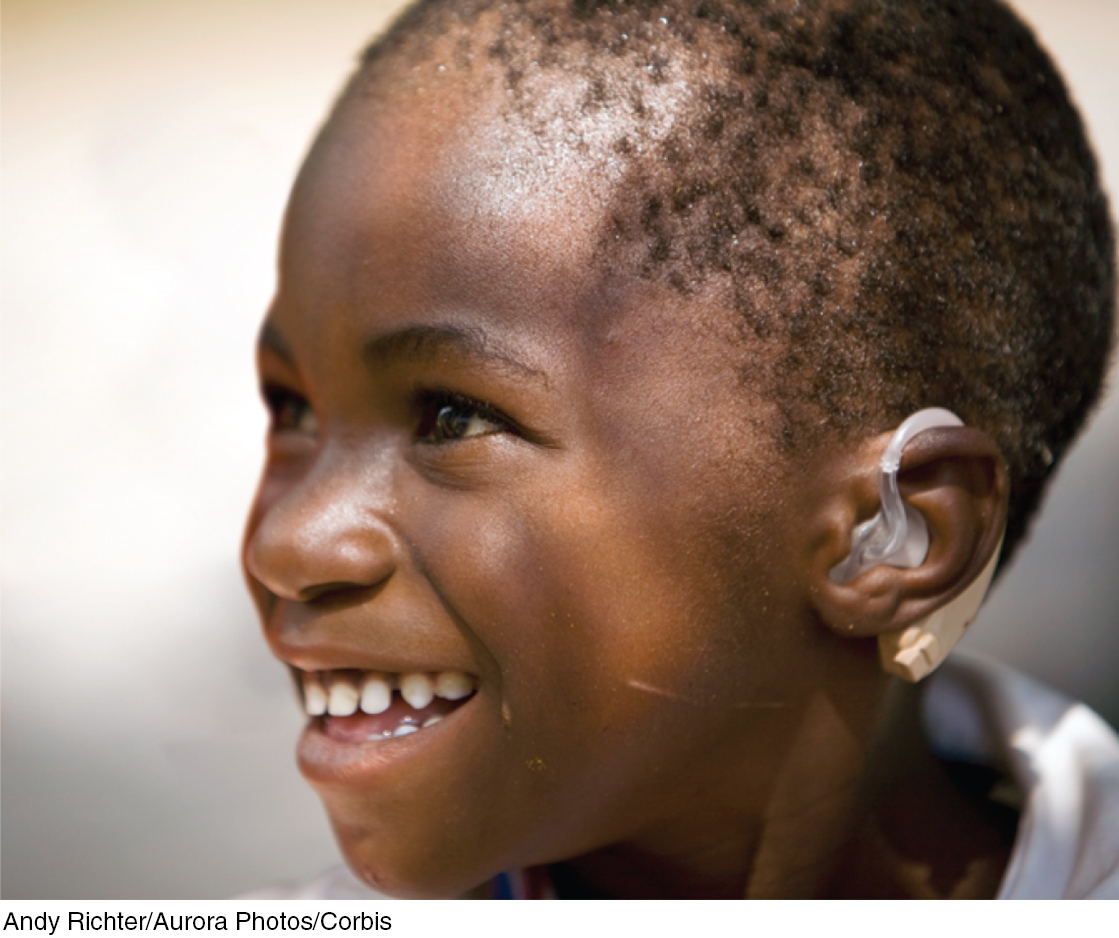
RETRIEVE IT
Question
What was the premise of researcher Noam Chomsky's work in language development?
Question
Why is it so difficult to learn a new language in adulthood?
The Brain and Language
9-
aphasia impairment of language, usually caused by left hemisphere damage either to Broca’s area (impairing speaking) or to Wernicke’s area (impairing understanding).
Broca’s area controls language expression—
We think of speaking and reading, or writing and reading, or singing and speaking as merely different examples of the same general ability—
 To review research on left and right hemisphere language processing—
To review research on left and right hemisphere language processing—
Wernicke’s area controls language reception—
In 1874, German investigator Carl Wernicke discovered that after damage to an area of the left temporal lobe (Wernicke’s area), people could speak only meaningless sentences. Asked to describe a picture that showed two boys stealing cookies behind a woman’s back, one patient responded: “Mother is away her working her work to get her better, but when she’s looking the two boys looking the other part. She’s working another time” (Geschwind, 1979). Damage to Wernicke’s area also disrupts understanding.
Today’s neuroscience has confirmed brain activity in Broca’s and Wernicke’s areas during language processing (FIGURE 9.10). But language functions are distributed across other brain areas as well. Functional MRI scans show that what you experience as a continuous, indivisible stream of experience—
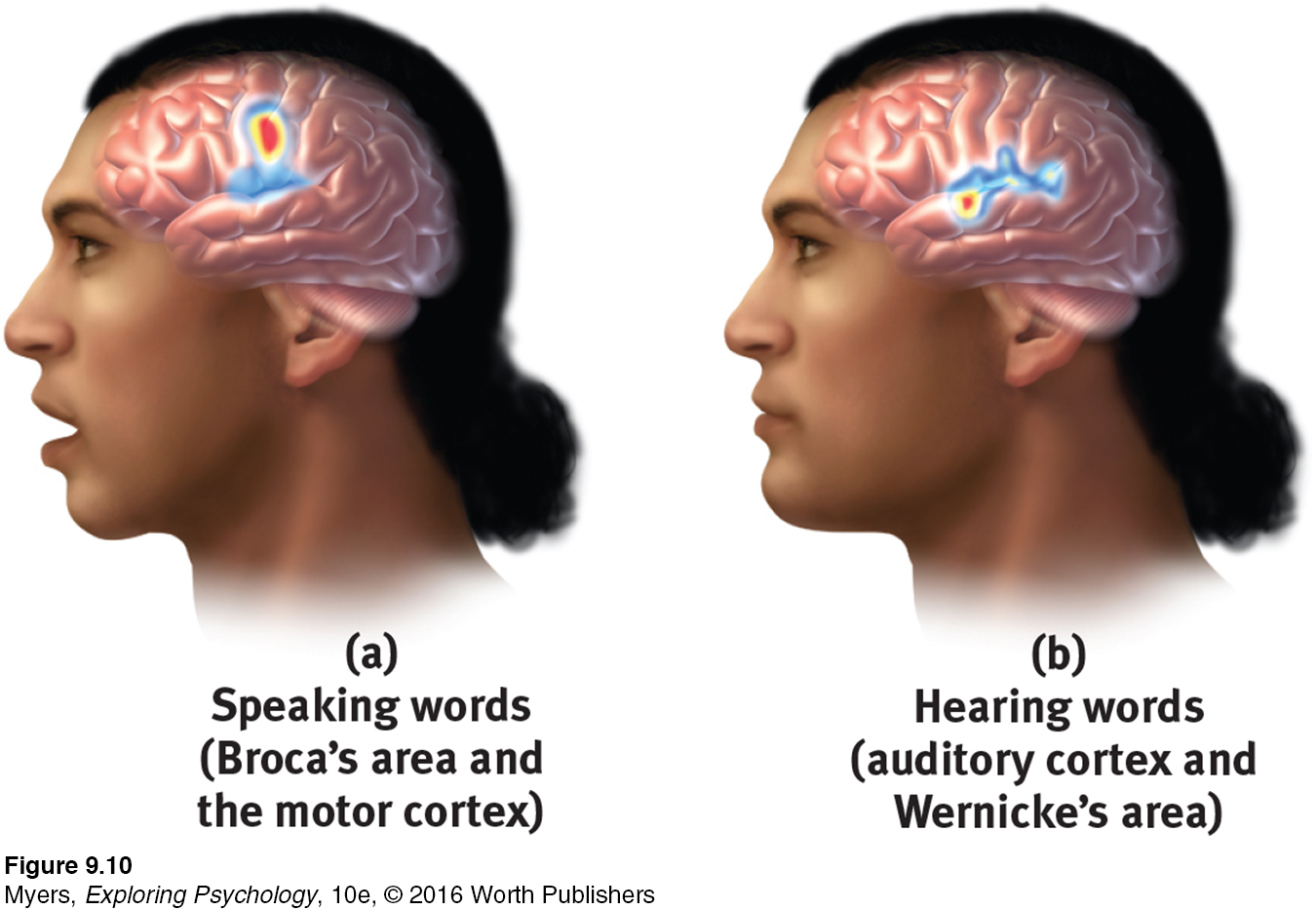
“It is the way systems interact and have a dynamic interdependence that is—
Simon Conway Morris, “The Boyle Lecture,” 2005
The big point to remember: In processing language, as in other forms of information processing, the brain operates by dividing its mental functions—
E pluribus unum: Out of many, one.
RETRIEVE IT
Question
________ is the part of the brain that, if damaged, might impair your ability to speak words. Damage to ________ might impair your ability to understand language.
Do Other Species Have Language?
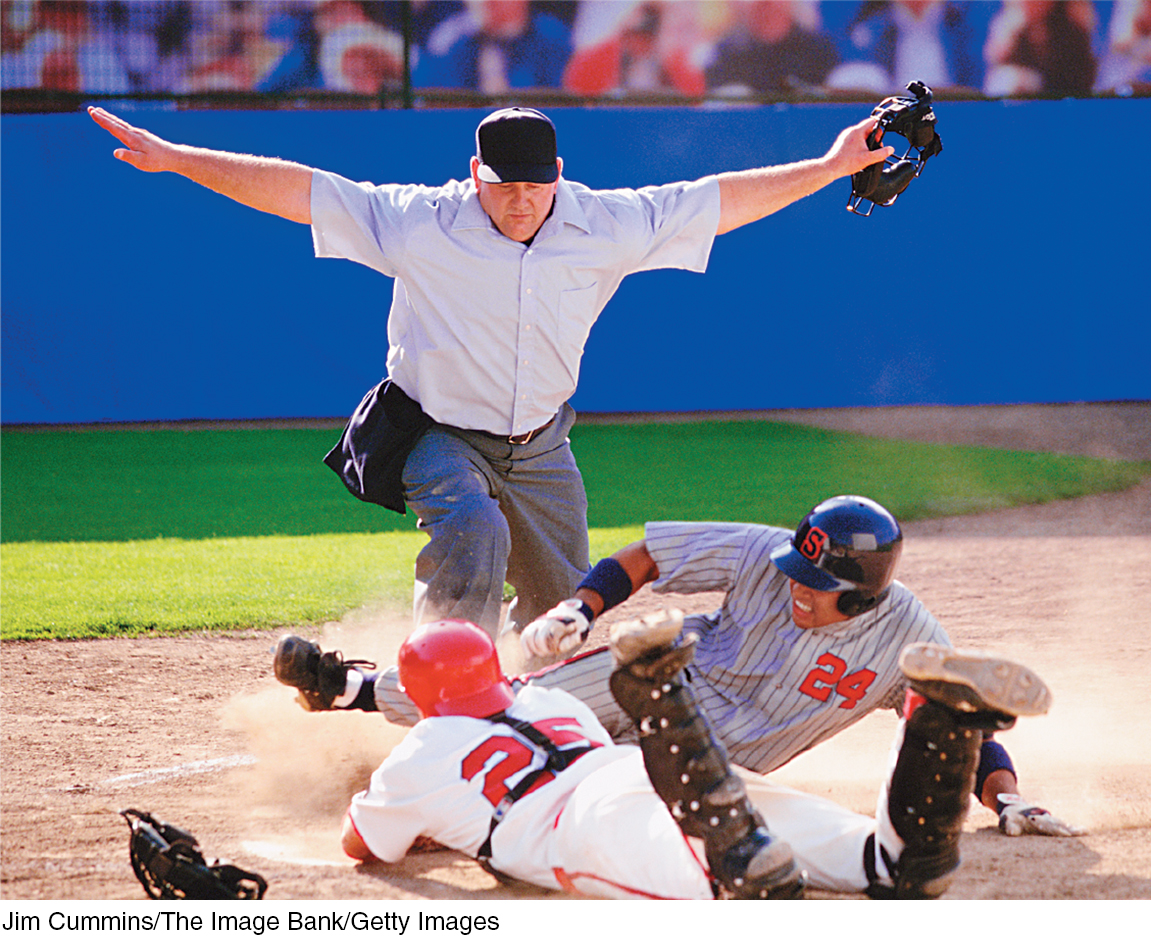
9-
Humans have long and proudly proclaimed that language sets us above all other animals. “When we study human language,” asserted Chomsky (1972), “we are approaching what some might call the ‘human essence,’ the qualities of mind that are, so far as we know, unique [to humans].” Is it true that humans, alone, have language?
Animals display impressive comprehension and communication. Vervet monkeys sound different alarm cries for different predators: a barking call for a leopard, a cough for an eagle, and a chuttering for a snake. Hearing the leopard alarm, other vervets climb the nearest tree. Hearing the eagle alarm, they rush into the bushes. Hearing the snake chutter, they stand up and scan the ground (Byrne, 1991). To indicate threats, monkeys can also combine 6 different calls into a 25-
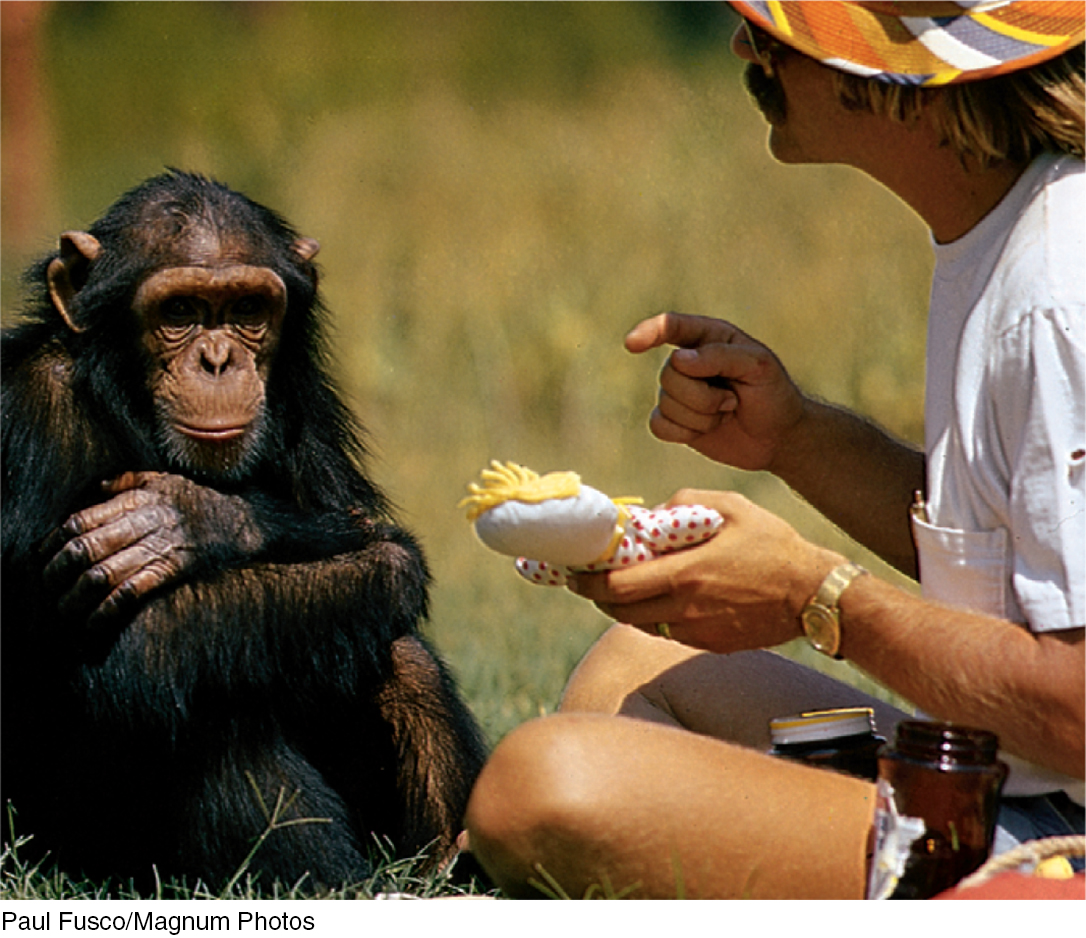
 For examples of intelligent communication and problem solving among orangutans, elephants, and killer whales, watch LaunchPad’s 6-
For examples of intelligent communication and problem solving among orangutans, elephants, and killer whales, watch LaunchPad’s 6-
In the late 1960s, psychologists Allen Gardner and Beatrix Gardner (1969) built on chimpanzees’ natural tendencies for gestured communication by teaching sign language to a chimpanzee named Washoe. After four years, Washoe could use 132 signs; by her life’s end in 2007, she was using more than 245 signs (Metzler, 2011; Sanz et al., 1998). One New York Times reporter, having learned sign language from his deaf parents, visited Washoe and exclaimed, “Suddenly I realized I was conversing with a member of another species in my native tongue.” Some chimpanzees strung signs together to form sentences. Washoe, for example, signed “You me go out, please.” Some word combinations seemed creative—
Ape vocabularies and sentences are simple, rather like those of a 2-
year- old child. And unlike speaking or signing children, apes gain their limited vocabularies only with great difficulty (Wynne, 2004, 2008). Chimpanzees can make signs or push buttons in sequence to get a reward. But pigeons, too, can peck a sequence of keys to get grain (Straub et al., 1979). The apes’ signing might be nothing more than aping their trainers’ signs and learning that certain arm movements produce rewards (Terrace, 1979).
Studies of perceptual set (described in Chapter 6) show that when information is unclear, we tend to see what we want or expect to see. Interpreting chimpanzee signs as language may be little more than the trainers’ wishful thinking (Terrace, 1979). When Washoe signed water bird, she may have been separately naming water and bird.
“Give orange me give eat orange me eat orange . . .” is a far cry from the exquisite syntax of a 3-
year- old (Anderson, 2004; Pinker, 1995).
Controversy can stimulate progress, and in this case, it triggered more evidence of chimpanzees’ abilities to think and communicate. Kanzi, a bonobo with a reported 384-

So, how should we interpret these case studies? Are humans the only language-
RETRIEVE IT
Question
If your dog barks at a stranger at the front door, does this qualify as language? What if the dog yips in a telltale way to let you know she needs to go out?
Thinking and Language
9-
Thinking and language intricately intertwine. Asking which comes first is one of psychology’s chicken-
Language Influences Thinking
Linguist Benjamin Lee Whorf (1956) contended that “language itself shapes a [person’s] basic ideas.” The Hopi, who have no past tense for their verbs, could not readily think about the past, said Whorf.
linguistic determinism Whorf’s hypothesis that language determines the way we think.
Whorf’s linguistic determinism hypothesis is too extreme. We all think about things for which we have no words. (Can you think of a shade of blue you cannot name?) And we routinely have unsymbolized (wordless, imageless) thoughts, as when someone, watching two men carry a load of bricks, wondered whether the men would drop them (Heavey & Hurlburt, 2008; Hurlburt et al., 2013).
Nevertheless, to those who speak two dissimilar languages, such as English and Japanese, it seems obvious that a person may think differently in different languages (Brown, 1986). Unlike English, which has a rich vocabulary for self-
Depending on which emotion they want to express, bilingual people will often switch languages. “When my mom gets angry at me, she’ll speak in Mandarin,” explained one Chinese-
Our words may not determine what we think, but they do influence our thinking (Boroditsky, 2011). We use our language in forming categories. In Brazil, the isolated Piraha people have words for the numbers 1 and 2, but numbers above that are simply “many.” Thus, if shown 7 nuts in a row, they struggle to lay out the same number from their own pile (Gordon, 2004).
Words also influence our thinking about colors. Whether we live in New Mexico, New South Wales, or New Guinea, we see colors much the same, but we use our native language to classify and remember them (Davidoff, 2004; Roberson et al., 2004, 2005). Imagine viewing three colors and calling two of them “yellow” and one of them “blue.” Later you would likely recall the yellows as being more similar. But if you speak the language of Papua New Guinea’s Berinmo tribe, which has words for two different shades of yellow, you would more speedily perceive and better recall the variations between the two yellows. And if your language is Russian, which has distinct names for various shades of blue, such as goluboy and siniy, you might recall the yellows as more similar and remember the blue better. Words matter.

Perceived differences grow as we assign different names. On the color spectrum, blue blends into green—

Given words’ subtle influence on thinking, we do well to choose our words carefully. Is “A child learns language as he interacts with his caregivers” any different from “Children learn language as they interact with their caregivers”? Many studies have found that it is. When hearing the generic he (as in “the artist and his work”) people are more likely to picture a male (Henley, 1989; Ng, 1990). If he and his were truly gender free, we shouldn’t skip a beat when hearing that “man, like other mammals, nurses his young.”
To expand language is to expand the ability to think. Young children’s thinking develops hand in hand with their language (Gopnik & Meltzoff, 1986). Indeed, it is very difficult to think about or conceptualize certain abstract ideas (commitment, freedom, or rhyming) without language! And what is true for preschoolers is true for everyone: It pays to increase your word power. That’s why most textbooks, including this one, introduce new words—
“All words are pegs to hang ideas on.”
Henry Ward Beecher, Proverbs from Plymouth Pulpit, 1887
Increased word power helps explain what McGill University researcher Wallace Lambert (1992; Lambert et al., 1993) has called the bilingual advantage. In published studies—
Lambert helped devise a Canadian program that has, since 1981, immersed millions of English-
Whether we are in the linguistic minority or majority, language links us to one another. Language also connects us to the past and the future. “To destroy a people, destroy their language,” observed poet Joy Harjo.

 IMMERSIVE LEARNING To consider how researchers have learned about the benefits of speaking more than one language, visit LaunchPad’s How Would You Know If There Is a Bilingual Advantage?
IMMERSIVE LEARNING To consider how researchers have learned about the benefits of speaking more than one language, visit LaunchPad’s How Would You Know If There Is a Bilingual Advantage?
RETRIEVE IT
Question
Benjamin Lee Whorf's controversial hypothesis, called , suggested that we cannot think about things unless we have words for those concepts or ideas.
Thinking in Images
When you are alone, do you talk to yourself? Is “thinking” simply conversing with yourself? Words do convey ideas. But sometimes ideas precede words. To turn on the cold water in your bathroom, in which direction do you turn the handle? To answer, you probably thought not in words but with implicit (nondeclarative, procedural) memory—
Indeed, we often think in images. Artists think in images. So do composers, poets, mathematicians, athletes, and scientists. Albert Einstein reported that he achieved some of his greatest insights through visual images and later put them into words. Pianist Liu Chi Kung harnessed the power of thinking in images. One year after placing second in the 1958 Tchaikovsky piano competition, Liu was imprisoned during China’s cultural revolution. Soon after his release, after seven years without touching a piano, he was back on tour. Critics judged Liu’s musicianship as better than ever. How did he continue to develop without practice? “I did practice,” said Liu, “every day. I rehearsed every piece I had ever played, note by note, in my mind” (Garfield, 1986).
“When we see a person walking down the street talking to himself, we generally assume that he is mentally ill. But we all talk to ourselves continuously—
Sam Harris, “We Are Lost in Thought,” 2011
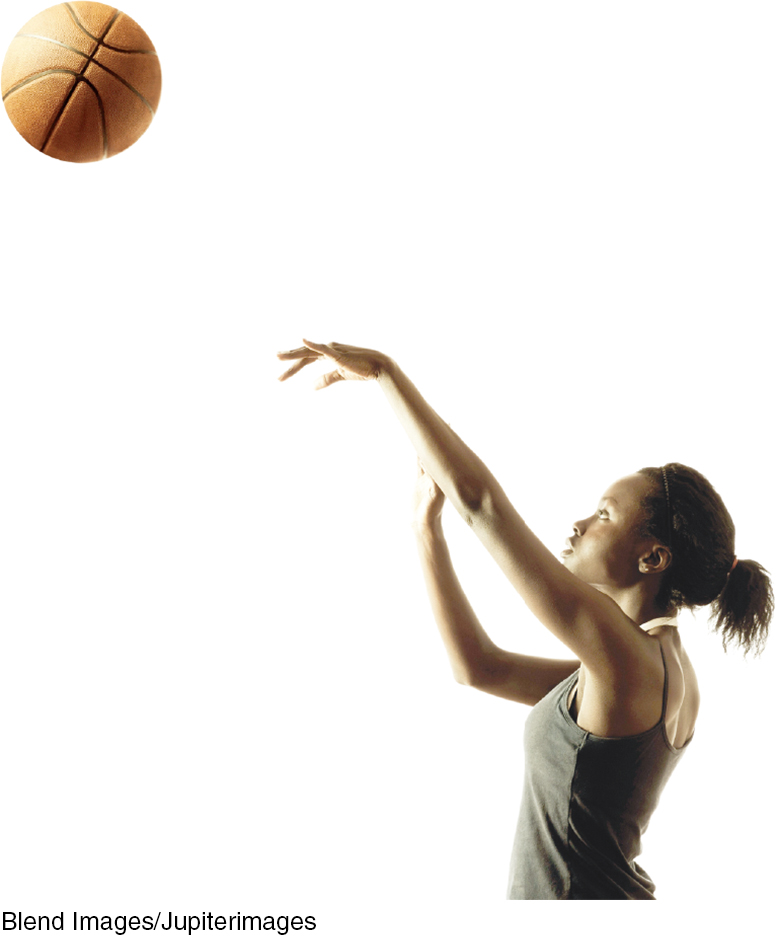
 To experience your own thinking as (a) manipulating words and (b) manipulating images, visit LaunchPad’s PsychSim 6: My Head Is Spinning!
To experience your own thinking as (a) manipulating words and (b) manipulating images, visit LaunchPad’s PsychSim 6: My Head Is Spinning!

For someone who has learned a skill, such as ballet dancing, even watching the activity will activate the brain’s internal simulation of it, reported one British research team after people underwent fMRIs while watching videos (Calvo-Merino et al., 2004). So, too, will imagining a physical experience, which activates some of the same neural networks that are active during the actual experience (Grèzes & Decety, 2001). Small wonder, then, that mental practice has become a standard part of training for Olympic athletes (Suinn, 1997; Ungerleider, 2005).
One experiment on mental practice and basketball free-throw shooting tracked the University of Tennessee women’s team over 35 games (Savoy & Beitel, 1996). During that time, the team’s free-throw accuracy increased from approximately 52 percent in games following standard physical practice to some 65 percent after mental practice. Players had repeatedly imagined making free throws under various conditions, including being “trash-
Mental rehearsal can also help you achieve an academic goal, as researchers demonstrated with two groups of introductory psychology students facing a midterm exam one week later (Taylor et al., 1998). (Scores of other students, not engaging in any mental simulation, formed a control group.) The first group spent five minutes each day visualizing themselves scanning the posted grade list, seeing their A, beaming with joy, and feeling proud. This outcome simulation had little effect, adding only 2 points to their exam-
The point to remember: It’s better to spend your fantasy time planning how to get somewhere than to dwell on the imagined destination.
* * *
What, then, should we say about the relationship between thinking and language? As we have seen, language influences our thinking. But if thinking did not also affect language, there would never be any new words. And new words and new combinations of old words express new ideas. The basketball term slam dunk was coined after the act itself had become fairly common. So, let us say that thinking affects our language, which then affects our thought (FIGURE 9.12).
Psychological research on thinking and language suggests that the human mind is simultaneously capable of striking intellectual failures and striking intellectual power. Misjudgments are common and can have disastrous consequences. So we do well to appreciate our capacity for error. Yet our efficient heuristics often serve us well. Moreover, our ingenuity at problem solving and our extraordinary power of language mark humankind as almost “infinite in faculties.”
RETRIEVE IT
Question
What is mental practice, and how can it help you to prepare for an upcoming event?
REVIEW Language and Thought
Learning Objectives
Test Yourself by taking a moment to answer each of these Learning Objective Questions (repeated here from within the chapter). Research suggests that trying to answer these questions on your own will improve your long-
Question
9-
Question
9-
Question
9-
Question
9-
Question
9-
Terms and Concepts to Remember
Test yourself on these terms.
Question
language (p. 329) phoneme (p. 330) morpheme (p. 330) grammar (p. 330) babbling stage (p. 331) one- two- telegraphic speech (p. 332) aphasia (p. 334) Broca's area (p. 334) Wernicke's area (p. 334) linguistic determinism (p. 336) | in a language, the smallest unit that carries meaning; may be a word or a part of a word (such as a prefix). beginning at about 4 months, the stage of speech development in which the infant spontaneously utters various sounds at first unrelated to the household language. beginning about age 2, the stage in speech development during which a child speaks mostly in two- our spoken, written, or signed words and the ways we combine them to communicate meaning. impairment of language, usually caused by left hemisphere damage either to Broca's area (impairing speaking) or to Wernicke's area (impairing understanding). early speech stage in which a child speaks like a telegram— the stage in speech development, from about age 1 to 2, during which a child speaks mostly in single words. controls language reception— Whorf's hypothesis that language determines the way we think. controls language expression— in a language, the smallest distinctive sound unit. in a language, a system of rules that enables us to communicate with and understand others. In a given language, semantics is the set of rules for deriving meaning from sounds, and syntax is the set of rules for combining words into grammatically sensible sentences. |
Experience the Testing Effect
Test yourself repeatedly throughout your studies. This will not only help you figure out what you know and don’t know; the testing itself will help you learn and remember the information more effectively thanks to the testing effect.
Question 9.8
1. Children reach the one-
| A. |
| B. |
| C. |
| D. |
Question 9.9
2. The three basic building blocks of language are , , and .
Question 9.10
3. When young children speak in short phrases using mostly verbs and nouns, this is referred to as .
Question 9.11
4. According to Chomsky, all languages share a(n) .
Question 9.12
5. Most researchers agree that apes can
| A. |
| B. |
| C. |
| D. |
Use  to create your personalized study plan, which will direct you to the resources that will help you most in
to create your personalized study plan, which will direct you to the resources that will help you most in  .
.